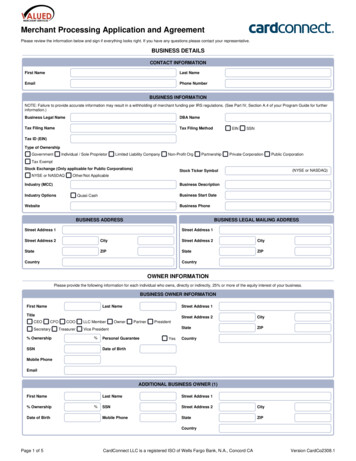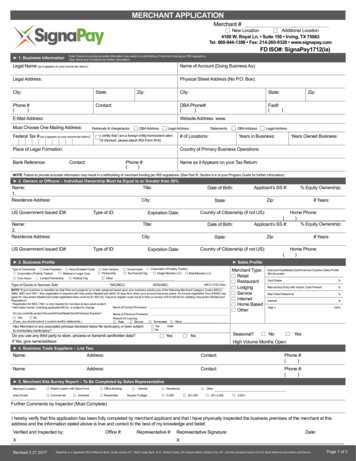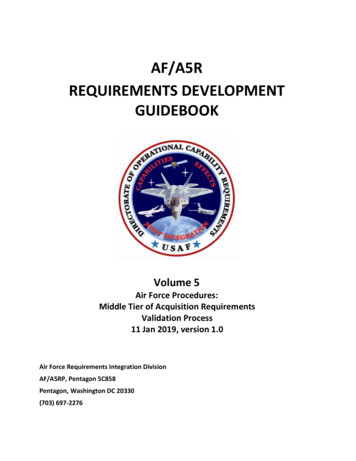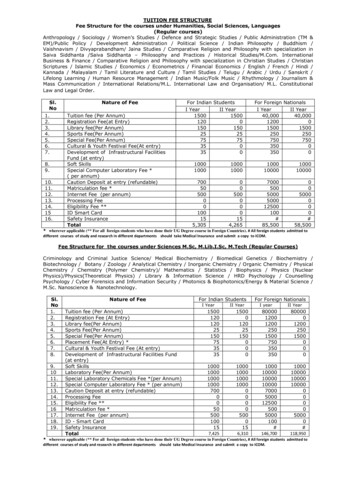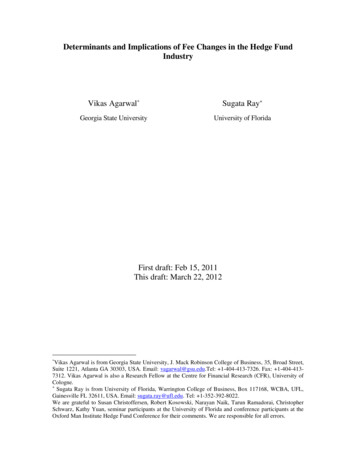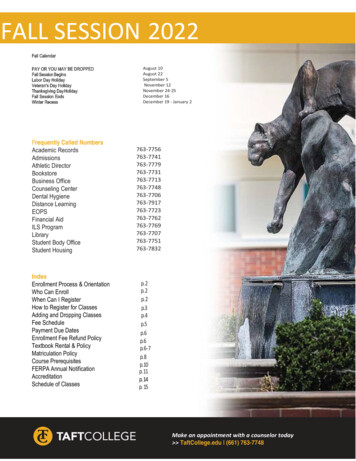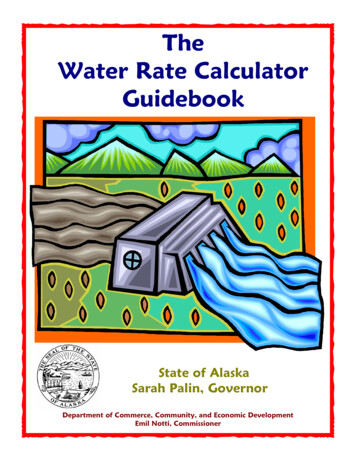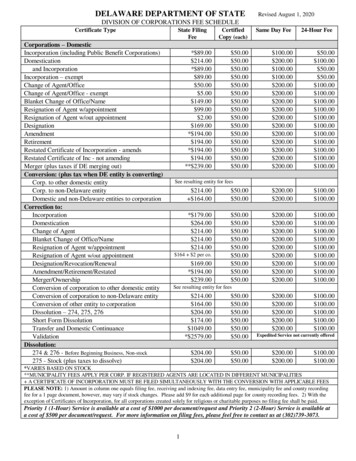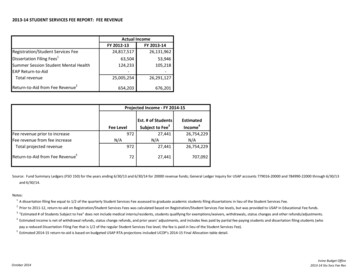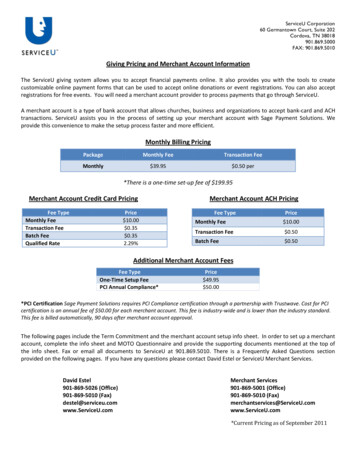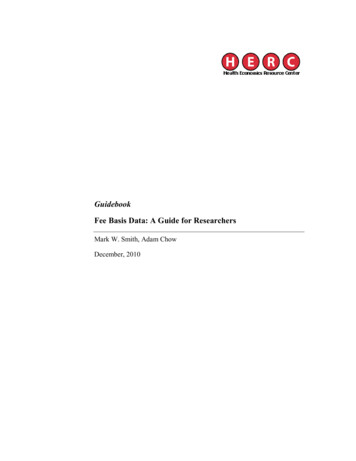
Transcription
GuidebookFee Basis Data: A Guide for ResearchersMark W. Smith, Adam ChowDecember, 2010
Fee Basis Data: A Guide for Researchers.Health Economics Resource Center (HERC)VA Palo Alto Healthcare System795 Willow Road (152 MPD)Menlo Park, CA 94025650-617-2630650-716-2639 (fax)herc@va.govSuggested citation: Smith MW, Chow A. Fee Basis Data: A Guide for Researchers. Menlo Park,CA. VA Palo Alto, Health Economics Resource Center; 2010.Acknowledgements: This research was supported by the Health Services Research andDevelopment Service, U.S. Department of Veterans Affairs (ECN 99017-1). We gratefullyacknowledge comments and contributions from Angela Fan, Nancy Hedrick, the late LesNiemiec, Ciaran Phibbs, Jerry Simpson, Andrea Shane, Patricia Sinnott, Todd Wagner, LynnWolfsfeld, and Ellen Zufall.Guidebook: Fee Basis Data ii
ContentsTerms . v1.Overview . 12.2.1.2.2.2.3.Data . 3File names. 3File contents . 3Missingness . 93.3.1.3.2.Access . 16Austin Information Technology Center (AITC) . 16Web-based access . 164.4.1.4.2.4.3.4.4.Institutional Aspects of the Fee Basis System. 18Coverage . 18Veteran status . 19Fee Card eligibility . 19Payment rules . 205.5.1.5.2.5.3.5.4.Recommendations for Analyzing Fee Basis Data . 24Finding records . 24Creating discharge records from invoice records . 24Apparent data anomalies . 25Facility charges vs. ancillary charges . 256.6.1.6.2.Resources. 26Contacts for the Fee Basis program . 26Fee Basis program web site . 26References . 28Guidebook: Fee Basis Data iii
Tables and AppendicesTable 1: AITC File Names and Brief Descriptions . 3Table 2: Names and Formats of Geographic Variables, FY2009 . 5Table 3: Number of Diagnosis and Procedure Codes, by File and Year Range . 6Table 4: Variables That Describe Setting and Type of Care, by File . 7Table 5: Important Payment Variables, by File . 8Table 6: Names and File Locations of Fee Basis Variables, FY2009 . 11Table 7: Selected Procedure Guides on the Fee Basis Intranet Site (January, 2010) . 27Appendix A.Contents of FY2009 Inpatient (INPT) File . 30Appendix B.Contents of FY2009 Inpatient Ancillary (ANCIL) File . 35Appendix C.Contents of FY2009 Outpatient (MED) File . 38Appendix D.Contents of FY2009 Pharmacy Payments (PHR) File . 40Appendix E.Contents of FY2009 Pharmacy Vendors (PHARVEN) File . 42Appendix F.Contents of FY2009 All Other Vendors (VEN) File . 43Appendix G.Contents of FY2009 Travel Payments (TVL) File . 45Appendix H.Contents of FY2009 Fee Card (VET) File . 46Appendix I.Formatted Values of Selected Variables in FY2009 . 48Appendix J.Fee Purpose of Visit (POV) Information and Table. 52Appendix K.SAS Program Example: Average Cost per CPT for One Vendor . 63Appendix L.Adjustment Code (ADJCD1 and ADJCD2) Values. 64Appendix M.Payment Guideline for Preauthorized Inpatient Claims . 65Appendix N.Payment for Physician and Non-physician Professional Services . 71Appendix O.Payment of Non-VA Outpatient Facility Charges . 75Guidebook: Fee Basis Data iv
TermsAITCAustin Information Technology CenterAWPAverage Wholesale PriceCDRCost Distribution ReportCFRCode of Federal RegulationsCMSCenter for Medicare and Medicaid ServicesCPTCurrent Procedural TerminologyCTCCost to ChargeDHCPDecentralized Hospital Computer ProgramDSSDecision Support SystemE&MEvaluation and managementFCDMFinancial and Clinical Data MartFMSFinancial Management SystemICD-9International Classification of Disease, 9th RevisionIRMSInformation Resource Management SystemsMPCRMonthly Program Cost ReportMSTMilitary Sexual TraumaNDENational Data ExtractNPCDNational Patient Care DatabaseNVHPTF Non-VA Hospitalization FileOPCOutpatient Care FilePTFPatient Treatment FileRBRVSResource-Based Relative Value SystemRVURelative Value UnitUSCUnited States CodeVAU.S. Department of Veterans AffairsVERAVeterans Equitable Resource AllocationVHAVeterans Health AdministrationVistAVeterans Health Information Systems and Technology ArchitectureGuidebook: Fee Basis Data v
1. OverviewThe Department of Veterans Affairs (VA) can make payments to non-VA health care providersunder many arrangements. The most common are sharing agreements with affiliate medicalschools and contracts with medical specialists. Non-VA care may also be authorized under theFee Basis program when VA cannot offer needed care, when a non-VA provider would beeconomical, or on an emergency basis when travel to a VA facility is medically infeasible. Inaddition, VA may place a Veteran in a private or state-run nursing home when a bed in a VAnursing home is unavailable or if the nursing home is distant from the patient’s residence.Payment for these types of care falls under the Fee Basis program.Most Fee Basis services fall into one of five categories: short-term acute inpatient care, oftenfollowed by transfer to a VA facility; community nursing home care; emergency outpatienttreatment; home-based care; and ongoing outpatient treatment in cases where the nearest VAfacility is distant. Fee Basis payments represented over 10% of total VA health care spending inFY2009 and a much larger fraction of payments for services often provided under contract, suchas long-term care.Each VA station tracks Fee Basis invoices and submits reports to the national office. Thesereports are merged to form a system-wide database consisting of eight files: four that recordhealth care encounters and four for administrative and travel records. These files are available forresearch use by VA employees following a standard approval process. They feature informationon patients, providers, care provided, charges and payments, and financial processing. The filesare accessible to VA employees through timeshare accounts at the VA Austin AutomationCenter.The Fee Basis data will be most useful for studying conditions where contract care is common,such as home-based care and nursing care, and for determining typical non-VA charges forhealth care services (both charges and payments are reported) and comparing those to VA costs.Relatively few published studies have made use of Fee Basis data. Chapko, Ehreth, and Hedrick(1991) discuss Fee Basis data in their early review of methods for determining the cost of VAhealth care. A large study of VA adult day health care (ADHC) programs counted contract carepaid through Fee Basis and other programs (Chapko et al. 1993). Two studies have investigatedthe use of Fee Basis care by female Veterans. Frayne et al. (2002) surveyed Women VeteransCoordinators at VA facilities to determine how often Fee Basis care was used to provide lowvolume services to female Veterans. They found that most centers use Fee Basis care forprocedures specific to females (e.g., mammography and gynecologic oncology), although veryfew used it for military sexual trauma counseling. Washington et al. (2003) assessed theavailability of women’s health services at VA facilities serving 400 or more women per year. FeeBasis and other contract care accounted for very small proportions of most services, except forserum pregnancy test (9.0% of 136 sites) and screening mammography (62.2%). Youssef andothers (2010) employed Decision Support System (DSS) and Fee Basis data to study VA cost oftreating S. aureus and C. difficile infections. Finally, Palmer et al. (2010) studied the quality ofcare among Fee Basis providers of colonoscopy.Guidebook: Fee Basis Data 1
This guidebook is intended to help researchers understand and use national Fee Basis files. Itdescribes characteristics of Fee Basis data such as contents, missingness, and concordancebetween files, and makes recommendations about its use for research. Chapter 1 presents anoverview of the guidebook. Chapter 2 and its appendices describe all variables in the FY2009Fee Basis files, including variable name, type, length, and missingness. Chapter 3 describes howto access the data through the Austin Automation Center or the VHA Support Services Centerweb site on the VA private network. Chapter 4 and its appendices offer detailed informationabout Fee Basis eligibility and payment rules, information critical to understanding utilizationand cost patterns in the data. In Chapter 5 we summarize our notes and recommendations forresearchers. Chapter 6 provides references for further information, including contact informationfor VA administrators knowledgeable about the Fee Basis program and data.Guidebook: Fee Basis Data 2
2. Data2.1.File namesThere are eight Fee Basis files for each fiscal year. Table 1 lists their Austin InformationTechnology Center (AITC) file names and gives a general description of their contents. The filesare stored in SAS data file format.Table 1: AITC File Names and Brief DescriptionsType of DataName SuffixFull AITC File Name¹Hospital staysINPTMDPPRD.MDP.SAS.FEN.FYyy.INPTInpatient ancillary services andphysician atient servicesMEDMDPPRD.MDP.SAS.FEN.FYyy.MEDPayments to pharmaciesPHRMDPPRD.MDP.SAS.FEN.FYyy.PHRTravel expensesTVLMDPPRD.MDP.SAS.FEN.FYyy.TVLPharmacy vendorsPHARVENMDPPRD.MDP.SAS.FEN.FYyy.PHARVENAll other vendorsVENMDPPRD.MDP.SAS.FEN.FYyy.VENFee Basis ID Cardsfor selected VeteransVETMDPPRD.MDP.SAS.FEN.FYyy.VET¹ Substitute the last two digits of the fiscal year for ‘yy’ in the file names above.2.2.File contentsCare provided through the Fee Basis program is entered by VA staff into the VistA Fee Basispackage. Data entries are based on invoices submitted to VA, at times supplemented byinformation gathered during telephone calls to the non-VA providers. Extracts from local VistAsystems are merged to form national Fee Basis data files.The data files in each fiscal year represent all claims paid during the year. They do not representall claims received or processed during the year. Most importantly, they do not represent all careprovided during the fiscal year. This is a critical difference from other VA utilization files suchas the DSS national data extracts, the Outpatient Care File (OPC) and the Patient Treatment FileGuidebook: Fee Basis Data 3
(PTF). To find all care provided in a particular fiscal year requires searching by treatment dateover several years of Fee Basis claims, a process described in more detail below.About 120 variables appear in one or more of the Fee Basis files. Table 6 – placed at the end ofthis chapter due to its length – lists each variable and indicates with an ‘X’ which files thevariable appears in. In some cases there are two or more variables representing the sameconcept. For example, fiscal year appears as “FISYR” in three files and “FY” in two others. Anofficial data dictionary has not been created for the Fee Basis files. We therefore used the SASprocedure PROC CONTENTS to generate a list of all variables. Results appear in Appendices Ato H, where each appendix pertains to a separate Fee Basis file. For each variable we report thename, type (numeric or character), length, format, and label. We also report its rate ofmissingness, generated from a different SAS procedure.In the inpatient stay (INPT) file, a record represents services rendered during one invoice period.Facilities may invoice VA once per calendar month, and so a stay that covers parts of twocalendar months will often be represented by two (or more) invoices. In the inpatient ancillary(ANCIL) and outpatient services (MED) files, each record shows a single Current ProcedureTerminology (CPT) code per record representing a single procedure or encounter. Someencounters have multiple procedures that are paid as a single encounter; other encounters havemultiple procedures and there are separate payments for each procedure.A single inpatient encounter may generate zero, one, or multiple ANCIL records, depending onthe number of ancillary procedures and physician services received. Each record in the pharmacyservices (PHR) file represents a single prescription, whether for a medication or a pharmacysupply (e.g., skin cleanser, bathing cloths). Each record in the vendor files (PHARVEN, VEN)pertains to a particular vendor, while Fee ID Card records in the VET file correspond toindividual Veterans rather than the particular services those Veterans have received.Below we summarize the contents for six categories of variables: patient demographics, militaryservice, location, clinical aspects, payment, and financial processing within VA.2.2.1. Demographic variablesThe demographic information in the Fee Basis files is very limited. The VET file has a variablefor gender (SEX) and, for decedents, the date of death (DEATHDT). Because the VET filecontains relatively few records, researchers must match Fee Basis records to other VA databases,such as the Outpatient Care File (OPC/NPCD), the Patient Treatment File (PTF), of the DecisionSupport Systems (DSS) National Data Extracts to obtain demographic data. The Fee Basis fileshave a patient ID variable (scrambled SSN [SCRSSN]) that enables researchers to merge thesedata.2.2.2. Military service variablesVariables representing period of service (WARCODE) and prisoner-of-war status (POW) appearin the VET file. No other service-related variables appear in the Fee Basis files. Service variablesfor all Fee Basis patients can be obtained from other VA databases.Guidebook: Fee Basis Data 4
2.2.3. Geographic variablesEvery Fee Basis file contains variables for county of residence and state of residence (includingCanadian provinces and certain foreign countries). Table 2 lists the variable names and formats.We checked the concordance of corresponding numeric and character values across records intwo years of Fee Basis data. Numeric values were associated with the same character valuesconsistently, except when HOMSTATE took the values of ‘90’ or ’99.’ Potential errors inHOMSTATE appear in HOMECNTY as well, which is derived by concatenating HOMSTATEand CNTY.Table 2: Names and Formats of Geographic Variables, FY2009VariableNumeric FormatCharacter FormatVA StationSTA3N (4 digits)STA6A (6 digits)STANUM (6 � Includes Canadian provinces, Puerto Rico, Guam, and the PhilippinesSTA3N, STA6A, and STANUM refer to the station at which the data are input, which should bethe station paying for the service. The primary service area (HOMEPSA) indicates the station towhich the Veteran’s residence is assigned based on geography. It not necessarily the station atwhich the Veteran receives most VA care or the station which will pay for a particular Fee Basisservice. To locate the facility at which the Veteran usually receives VA care, VIReCrecommends consulting the preferred facility indicator in the VHA Enrollment Database (VIReC2007). For a brief presentation of the rules governing which VA station must pay for a particularFee Basis service, see the notes of the Fee Program Office national call on 8 November 2007,available on the Fee Basis intranet web site.2.2.4. Clinical variablesTable 3 shows the number of diagnosis and procedure variables in each of the Fee Basis files.Through FY2008 there were up to five ICD-9 discharge diagnosis codes recorded in the inpatientdischarge (INPT) file and no admission diagnoses. Starting in FY2009 there are up to 25discharge diagnoses and up to 25 admission diagnoses. The outpatient services file reports asingle discharge diagnosis (DXLSF) alone. There were no diagnosis codes in the ancillary andphysician services (ANCIL) file until FY2009, when a single discharge diagnosis code (DXLSF)was added. Ancillary file records can be linked by patient ID and service dates to dischargerecords in the INPT file. Diagnosis codes do not appear on the pharmacy (PHR) file.Guidebook: Fee Basis Data 5
Table 3: Number of Diagnosis and Procedure Codes, by File and Year RangeInpatientFacility(INPT)VariableNameAdmission DiagnosesDXPOA1DXPOA25-FY2008: 0FY2009-: 25000000Discharge DiagnosesDXLSF,DX2-DX25-FY2008: 5FY2009-: 25011100Inpatient ProceduresSURG9CD1- -FY2008: 5SURG9CD25 FY2009-: 25000000Ancillary, Physician, orOutpatient ProceduresCPT1110-FY2007: 0FY2008-: 4-FY2004: 0FY2005-: 400CPT modifiersCPTMD1CPTMD4* A variable exists but all values are D)PharmacyVariable(PHR)Procedure codes appear in the inpatient procedures file (INPT) and the outpatient services file(MED). Through FY2008 there were up to five ICD-9 procedure codes; starting in FY2009 thiswas raised to 25 codes. Each outpatient (MED) record contains a single CPT procedure code.There are also up to four two-character CPT modifier codes in the ancillary (ANCIL) andoutpatient (MED) files. They were added to the ancillary file in FY2008 and to the outpatientfile in FY2005.Six additional variables indicate the setting of care and vendor or care type. They appear inTable 4, where an ‘X’ indicates that the variable appears in the file. Vendor type (TYPE),payment category (PAYCAT), treatment code (TRETYPE), and place of service (PLSER) allprovide information on the type or setting of care. They could form part of an overall strategy tolocate care provided in specialized settings, such as state homes, or of specialized services likekidney dialysis. PLSER values overlap considerably with those of the Medicare Carrier LinePlace of Service codes. The Fee Purpose of Visit (FPOV) and Health Care Financing AgencyPayment Type (HCFATYPE) variables feature values pertaining to setting (inpatient, outpatient,home-based), specific items (e.g., supplies and diagnostics), and miscellaneous purposes. 11The Health Care Financing Administration (HCFA) has been renamed the Centers for Medicare and MedicaidServices (CMS).Guidebook: Fee Basis Data 6
Table 4: Variables That Describe Setting and Type of Care, by ient(MED)Pharmacy(PHR)TYPEXXXXPayment CategoryPAYCATX*XXFee Purpose of VisitFPOVXXXHCFA Payment TypeHCFATYPEXXTreatment CodeTRETYPEPlace of ServicePLSERVariableVariableNameTypeXXX* Variable exists but all values are missing.Formatted FY2009 values for Fee Purpose of Visit (FPOV), HCFA Payment Type (HCFFMT),Treatment Code (TRETYPE), Place of Service (PLSER), and Vendor Type (TYPE) appear inAppendix I, starting on page 48. New values may be added over time. Appendix J, copied fromthe Fee Basis program web site, describes in detail the types of records for which each FeePurpose of Visit (FPOV) codes is assigned.2.2.5. Payment variablesThe Fee Basis files’ primary purpose is to record VA payments to non-VA providers. Table 5lists the most important payment variables and in which files they appear. Additional variables,most of them relating to FMS processing, appear in Table 6 at the end of this chapter.The Amount Claimed (PAMTCL) appears in the inpatient (INPT) file alone. Claimed amountsshould be listed on all invoices submitted to VA, but except for inpatient facility claims they arenot added to the Fee Basis files. It may be possible to extract claimed amounts for files otherthan INPT from the VistA system of a particular medical center.The amount paid to vendors is expressed in two variables, Payment Amount (AMOUNT) andFMS Disbursed Amount (DISAMT). Before FY2007 DISAMT had an implied decimal pointwhereas AMOUNT did not. Starting in FY2007 the two variables are equal, although the numberof nonmissing values still differs slightly between them and so annual totals will not exactlymatch.Care provided under contract are eligible for interest payments. Thus the variable INTIND(interest indicator), which equals ‘1’ if the claim is eligible for interest and ‘0’ otherwise, is alsoan indicator of contract care. The amount of interest paid on the claim, if any, appears as thevariable INTAMT. It has two implied decimal places. For example, an interest payment ofGuidebook: Fee Basis Data 7
Table 5: Important Payment Variables, by FileVariableVariableNameInpatient(INPT)Claimed amountPAMTCLXPayment amountAMOUNTXXXXFMS disbursed amountDISAMTXXXXFMS interest indicatorINTINDXXXXFMS interest amountINTAMTXXXXMedicare pricer amount cy(PHR)X* Includes the physician charge when that is not billed separately. 14.21 would appear as ‘1421.’ INTAMT is part of AMOUNT and DISAMT; it should not beadded to them.The inpatient (INPT) file includes PAMT, the Medicare prospective payment that would apply tothe stay. VA calculates PAMT from CMS pricer software on the basis of DRG and length ofstay. There are additional payments for direct medical education, capital-related costs, and otherfactors as appropriate. The VA payment (DISAMT) is typically less than or equal to the PAMTvalue, although in some cases VA will pay more than Medicare would pay. For more details,including rules for handling patients transferred during a stay, see federal regulation 38 CFR17.55.The important payment variables that appear in the ANCIL file likewise are found in theoutpatient MED file. They include the two variables that show the total payment (AMOUNTand DISAMT) and the interest portion of the total payment, if any (INTAMT).The pharmacy vendors (PHARVEN) and all other vendors (VEN) files contain only summarypayments by month. These data records cannot be linked to particular patients or encounters.Likewise, the Fee Card (VET) file contains only summary payment figures by month, althoughresearchers can match the records to other data by SCRSSN and other identifiers. Research byVA staff members indicates that vendor ID (VENDID) in the VEN and PHARVEN files isconsistent across sites, reliably links to Fee Basis workload files, and corresponds to a vendorfile in VistA. 2 Appendix K presents a SAS program that calculates the average cost per CPTcode for a particular station. Through a simple modification it could be limited to a specificvendor as well.2Ellen Zufall, personal communication, 2 October 2006.Guidebook: Fee Basis Data 8
The travel payments (TVL) file shows reimbursements for particular travel events, TVLAMT.Through patient ID (SCRSSN) and travel date (TVLDTE) one can link these payments toencounters recorded in the encounter-level inpatient and outpatient files (INPT, ANCIL, MED).2.2.6. Financial processing variablesMany variables in the Fee Basis files record details of invoice and check processing. Most filescontain the invoice date, obligation number, check number and date, several variables pertainingto check cancellation and denials of payment, and the DHCP internal control number. Fiveadditional variables – Financial Management System (FMS) transaction number, line number,date, batch number, and release date – reflect processing of payments through the FMS. Withfew exceptions these variables will be of little interest to researchers.The payment amount variables (AMOUNT and DISAMT) are missing (blank) in a small numberof cases. These represent cases in which payment is disallowed. The values of AdjustmentCodes 1 and 2 (ADJCD1 and ADJCD2) explain the reason for non-payment. Appendix L liststheir current values.2.3.MissingnessThe last column of Appendices A to H shows the percentage of variable values missing in theFY2009 files. Rates of missingness are generally low. A few variables of interest to researchersare missing at least 95% percent of the time in certain files: MDCAREID: Medicare Provider ID (INPT, ANCIL files) – 100% missingCPT1: outpatient procedure code (INPT file) – 100% missingPAYCAT: payment category (ANCIL file) – 100% missingSeveral FMS processing variables (all files) – 98-100% missingSPECCODE: suspense code (VEN, PHARMVEN) – 100% missingThe Medicare provider ID (MDCAREID) is required by Medicare Pricer software to determinethe prospective payment for a stay. The values are missing for all records. In many cases theMedicare provider ID is unnecessary because the prospective payment already appears in thevariable PAMT. If a researcher wishes to find the provider ID, one approach is to use the vendoridentification variables (VEN13N, VENDID) to locate the vendor’s name and location in theVEN file, and then to use this information to find the Medicare provider ID using publiclyavailable files from CMS, the agency that oversees the Medicare program.Inpatient procedures are captured by ICD-9 codes (SURG9CD1-SURG9CD5), whereas theCPT1 code is typically used for outpatient procedures. The CPT1 variable in the inpatient(INPT) file appears to serve merely as a placeholder. The FMS processing variables and thesuspense code (SPECCODE or SUSCODE), whose 18 values refer to invoice processing orclaim type, are unlikely to be used for research. The payment category (PAYCAT) is missing forall records in the inpatient services (ANCIL) file. Missing values of PAYCAT could be imputedby finding the matching inpatient stay in the INPT file.Guidebook: Fee Basis Data 9
Researchers must consider whether a missing value means “not applicable.” For example, morethan 75% of inpatient (INPT) records lack a value for any of the surgery codes (SURG9CD1SURG9CD5). This most likely reflects a low frequency of surgery rather than missing data. TheFee Basis program will not pay for non-emergent surgery, and thus we should expect to seerelatively few of them in these data. Conversely, all stays should have at least one dischargediagnosis. A missing value of the primary diagnosis code (DXLSF) should therefore be treatedas truly missing. The same cannot be said for DX2-DX5, however, as additional diagnosis codesare optional.Notes and Recommendations The same concept (such as fiscal year, state, or county) may be represented by severalvariables, sometimes in differing formats. Missingness is generally very low except for selected variables. It can vary substantiallyby year and by file.Guidebook: Fee Basis Data 10
Table 6: Names and File Locations of Fee Basis Variables, FY20091VariableFee Basis NTYXXXXCPT13XCPTMD1XXX4XX51Variable labels appear in Appendices A-H.In the PHR file ADJATM1 is called ADJAM1 and ADJACMT2 is called ADJAM2.3Variable exists but all values are missing.4Added in FY2008.5Added in FY2005.2Guidebook: Fee Basis Data 11
Table 6: Names and File Locations of All Fee Basis Variables (cont’d) 1VariableFee Basis XXXXHCFATYPEXXHOMECNTY
The most common are sharing agreements with affiliate medical schools and contracts with medical specialists. Non-VA care may also be authorized under the . health care encounters and four for administrative and travel records. These files are available for research use by VA employees following a standard approval process. They feature .
